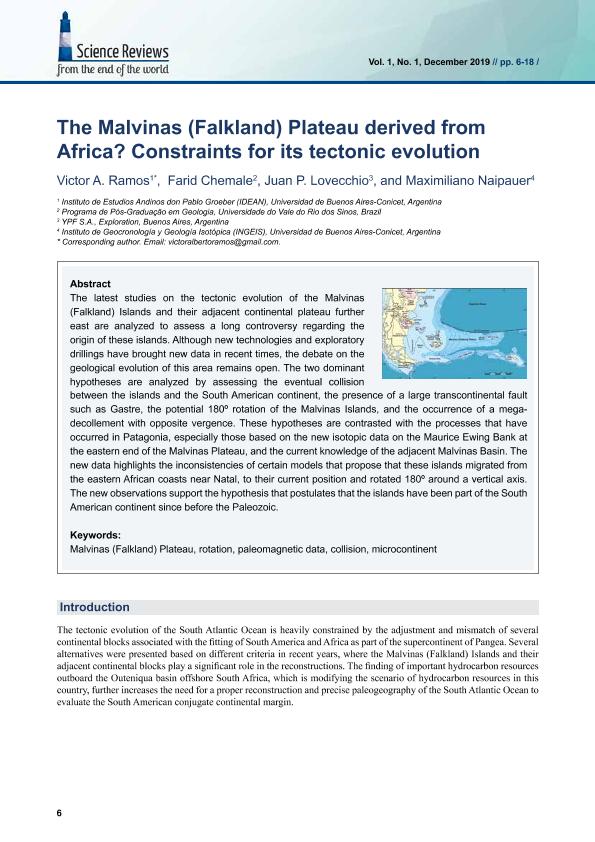Mostrar el registro sencillo del ítem
dc.contributor.author
Ramos, Victor Alberto

dc.contributor.author
Chemale, Farid

dc.contributor.author
Lovecchio, Juan Pablo

dc.contributor.author
Naipauer, Maximiliano

dc.date.available
2021-10-20T18:39:32Z
dc.date.issued
2020-07
dc.identifier.citation
Ramos, Victor Alberto; Chemale, Farid; Lovecchio, Juan Pablo; Naipauer, Maximiliano; The Malvinas (Falkland) Plateau derived from Africa?: Constraints for its tectonic evolution; Centro de Estudios sobre Ciencia, Desarrollo y Educación Superior; Science Reviews form the end of the World; 1; 1; 7-2020; 6-18
dc.identifier.issn
2683-9288
dc.identifier.uri
http://hdl.handle.net/11336/144534
dc.description.abstract
The latest studies on the tectonic evolution of the Malvinas (Falkland) Islands and their adjacent continental plateau further east are analyzed to assess a long controversy regarding the origin of these islands. Although there has been a controversy for several decades on this subject, new technologies and exploratory drilling have brought new data, however the debate of the geological evolution of this area remains open. The two dominant hypotheses are analyzed by assessing the eventual collision between the islands and the South American continent, the presence of a large transcontinental fault such as Gastre, the potential 180º rotation of the Malvinas Islands, and the occurrence of a mega-decollement with opposite vergence. These hypotheses are contrasted with the processes that have occurred in Patagonia, especially those based on the new isotopic data on the Maurice Ewing Bank at the eastern end of the Malvinas Plateau, and the current knowledge of the adjacent Malvinas Basin. The new data highlights the inconsistencies of certain models that proposed these islands migrated from the eastern African coasts near Natal, to their current position and rotated 180º on a vertical axis. The new observations are consolidating the hypothesis that postulates that the islands have been part of the South American continent since before the Paleozoic.
dc.format
application/pdf
dc.language.iso
eng
dc.publisher
Centro de Estudios sobre Ciencia, Desarrollo y Educación Superior
dc.rights
info:eu-repo/semantics/openAccess
dc.rights.uri
https://creativecommons.org/licenses/by-nc-sa/2.5/ar/
dc.subject
Malvinas plateau
dc.subject
Rotation
dc.subject
Collision
dc.subject
Microcontinent
dc.subject.classification
Geociencias multidisciplinaria

dc.subject.classification
Ciencias de la Tierra y relacionadas con el Medio Ambiente

dc.subject.classification
CIENCIAS NATURALES Y EXACTAS

dc.title
The Malvinas (Falkland) Plateau derived from Africa?: Constraints for its tectonic evolution
dc.type
info:eu-repo/semantics/article
dc.type
info:ar-repo/semantics/artículo
dc.type
info:eu-repo/semantics/publishedVersion
dc.date.updated
2021-09-07T18:34:03Z
dc.journal.volume
1
dc.journal.number
1
dc.journal.pagination
6-18
dc.journal.pais
Argentina

dc.journal.ciudad
Buenos Aires
dc.description.fil
Fil: Ramos, Victor Alberto. Consejo Nacional de Investigaciones Científicas y Técnicas. Oficina de Coordinación Administrativa Ciudad Universitaria. Instituto de Estudios Andinos "Don Pablo Groeber". Universidad de Buenos Aires. Facultad de Ciencias Exactas y Naturales. Instituto de Estudios Andinos "Don Pablo Groeber"; Argentina
dc.description.fil
Fil: Chemale, Farid. Universidad de Vale do Rio dos Sinos; Brasil
dc.description.fil
Fil: Lovecchio, Juan Pablo. Yacimiento Petroliferos Fiscal S.a.; Argentina
dc.description.fil
Fil: Naipauer, Maximiliano. Consejo Nacional de Investigaciones Científicas y Técnicas. Oficina de Coordinación Administrativa Ciudad Universitaria. Instituto de Geocronología y Geología Isotópica. Universidad de Buenos Aires. Facultad de Ciencias Exactas y Naturales. Instituto de Geocronología y Geología Isotópica; Argentina
dc.journal.title
Science Reviews form the end of the World
dc.relation.alternativeid
info:eu-repo/semantics/altIdentifier/url/http://www.scirevfew.net/index.php/sciencereviews/article/view/23
dc.relation.alternativeid
info:eu-repo/semantics/altIdentifier/doi/http://dx.doi.org/10.52712/sciencereviews.v1i1.23
Archivos asociados
